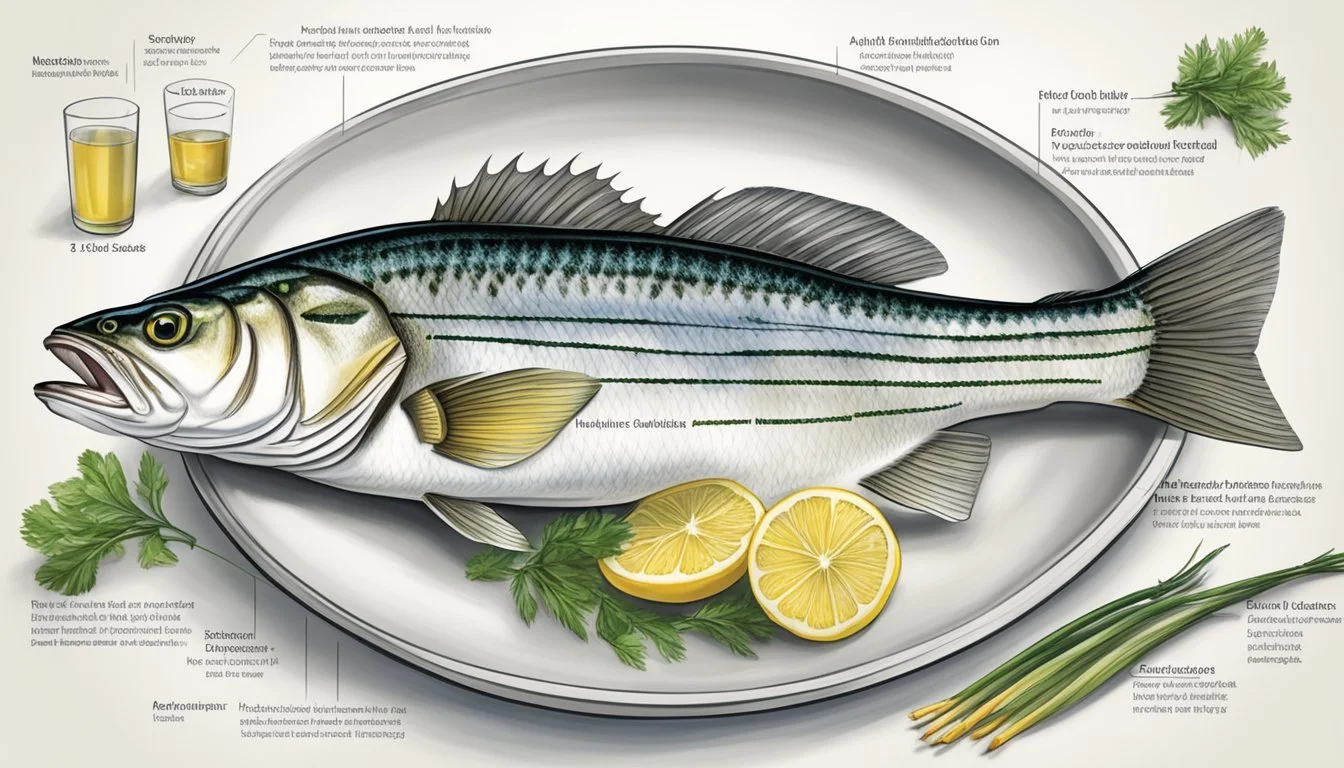Can Diabetics Eat Striped Bass?
Health Benefits and Risks
When it comes to managing diabetes, diet plays a crucial role, particularly the choice of proteins. Fish, especially striped bass, emerges as an excellent option due to its nutritional profile. Diabetics can benefit significantly from eating striped bass, given its high content of omega-3 fatty acids, which are known to improve insulin sensitivity and help regulate blood sugar levels.
Striped bass provides a rich source of complete and highly bioavailable protein, which is critical in maintaining muscle mass and supporting overall health. This fish is also low in calories, making it a suitable choice for weight management, a key factor in diabetes management. Furthermore, striped bass is low in mercury compared to other types of fish, reducing potential health risks associated with high mercury consumption.
In addition to its health benefits, striped bass offers versatility in meal preparation, allowing diabetics to enjoy delicious, varied, and nutritious meals. The combination of its beneficial fats, essential nutrients, and suitability for different cooking methods makes striped bass an appealing choice for those looking to manage their diabetes effectively.
Understanding Diabetes and Nutrition
Proper nutrition plays a crucial role in managing diabetes, impacting blood glucose levels, insulin response, and overall health.
Role of Diet in Managing Diabetes
Diet is essential for individuals with type 2 diabetes to maintain controlled blood glucose levels. Carbohydrate intake needs to be carefully managed, as carbs directly influence blood sugar.
Reducing carbohydrates to 26-45% of total calories can help balance glucose levels. Non-starchy vegetables, healthy fats, and proteins from meat, fish, eggs, and nuts are preferred.
Low-carb diets can improve insulin sensitivity and reduce the risk of complications like heart and kidney diseases.
Essential Nutrients for Diabetics
Diabetics need a balanced intake of proteins, fats, and carbohydrates. Proteins from fish, such as striped bass, provide essential amino acids.
Healthy fats like omega-3 from fish and plant oils support cardiovascular health.
Fiber from vegetables and whole grains helps stabilize blood glucose and improve digestion.
Vitamins and minerals are also critical. For example, vitamin D and magnesium play roles in insulin function.
A well-rounded diet ensures that diabetics get the necessary nutrients to manage their condition effectively.
The Nutritional Profile of Striped Bass
Striped bass is a highly nutritious fish that offers a range of health benefits. It is rich in essential nutrients such as protein, omega-3 fatty acids, and various vitamins and minerals.
Macronutrients in Striped Bass
Striped bass provides an excellent source of protein which supports muscle growth and repair. A 3-ounce (85-gram) serving of this fish contains about 20 grams of protein. This makes it a valuable addition to diets that require high protein intake, like those of diabetics.
Low in calories, this fish serves approximately 124 calories per 3-ounce portion. This makes it a suitable option for those looking to manage their weight. Additionally, striped bass is relatively low in fats, including saturated fats, which helps in maintaining a healthy cholesterol level.
Vitamins and Minerals in Striped Bass
Striped bass is also packed with essential vitamins and minerals. Notably, it contains significant amounts of selenium (approximately 39.8 micrograms per 3-ounce serving), which is crucial for metabolic functions and has antioxidant properties.
The fish is a good source of potassium as well, aiding in fluid balance and muscle contractions. Vitamin B12 is abundant in striped bass, important for red blood cell formation and neurological health. Vitamin D is another vital nutrient found in this fish, which is necessary for calcium absorption and bone health.
Striped Bass and Omega-3 Fatty Acids
One of the standout nutritional features of striped bass is its content of omega-3 fatty acids, including EPA and DHA. These fatty acids are known for their role in promoting heart health and reducing inflammation.
Omega-3s are vital for maintaining a healthy brain and can help in managing blood sugar levels, which is particularly beneficial for diabetics. Eating striped bass can thus contribute to cardiovascular health by providing these essential fatty acids.
EPA and DHA levels in striped bass make it a valuable fish for those looking to enhance their diet with beneficial fats.
Health Benefits of Striped Bass for Diabetics
Striped bass offers several health benefits for diabetics, including promoting heart health, reducing inflammation, and aiding in weight management.
Heart Health and Striped Bass Consumption
Striped bass is rich in omega-3 fatty acids, which are known to improve heart health. For diabetics, maintaining cardiovascular health is crucial due to their increased risk of heart disease. Omega-3s help lower LDL (bad cholesterol) levels while raising HDL (good cholesterol) levels.
In addition to cholesterol management, the omega-3s in striped bass help reduce the risk of heart attacks and other cardiovascular diseases. This fish also contains high levels of protein and essential vitamins and minerals like selenium, which further contribute to a healthy heart.
Inflammation Reduction and Immune Support
Inflammation is a common issue in diabetics, potentially leading to complications such as insulin resistance. Striped bass can help reduce inflammation because of its anti-inflammatory properties. The abundance of omega-3 fatty acids helps to decrease inflammatory markers in the body.
Besides reducing inflammation, striped bass supports the immune system. The high levels of selenium in this fish play a vital role in maintaining a strong immune response. This can be particularly beneficial for diabetics, who may have a weakened immune system.
Weight Management with Striped Bass
Maintaining a healthy body weight is important for managing diabetes effectively. Striped bass can aid in weight management due to its high protein content, which promotes feelings of fullness and helps control appetite. This can prevent overeating, a common issue that can exacerbate obesity and insulin resistance.
Additionally, the low-calorie nature of striped bass makes it a suitable option for those looking to reduce calorie intake without sacrificing essential nutrients. Regular consumption of lean protein sources like striped bass can help diabetics maintain or achieve a healthy weight, thus improving insulin sensitivity and overall blood sugar control.
Best Practices for Including Striped Bass in a Diabetic Diet
Incorporating striped bass into a diabetic diet involves mindful preparation, appropriate portion sizes, and suitable consumption frequency. This ensures the nutritional benefits are maximized without negatively affecting blood sugar levels.
Safe Cooking Methods for Striped Bass
Choosing the right cooking method for striped bass is crucial. Baking, grilling, and steaming are preferred because they preserve nutrients without adding extra fats. For seasoning, opt for herbs, lemon juice, and a small amount of olive oil instead of high-sodium or sugary sauces. Keeping the preparation simple and healthy ensures the dish remains low-calorie and diabetic-friendly.
Cooking Methods:
Baked: Place fish in a preheated oven with herbs and a splash of olive oil.
Grilled: Use a grill pan or outdoor grill with minimal oil to prevent sticking.
Steamed: Place fish in a steamer basket over boiling water, seasoned with herbs.
Appropriate Portion Sizes
For diabetics, portion control is key in managing blood sugar levels. A standard portion for cooked fish, including striped bass, is approximately 3 to 4 ounces. This size provides ample protein while ensuring calorie and carb intake remains manageable. Using a kitchen scale can help accurately measure portions.
Portion Size Tips:
Visual Guide: A 3-ounce portion is roughly the size of a deck of cards.
Weight Measurement: Utilize a food scale for precision.
Serving Frequency: If unsure, consult a healthcare provider for personalized advice.
Frequency of Consumption
Striped bass can be included in the diet two to three times per week. This frequency balances the intake of essential nutrients like omega-3 fatty acids and proteins without overconsuming fish-related contaminants. Both freshwater striped bass and those available as frozen fish can be considered, but always opt for high-quality, well-sourced products.
Consumption Guidelines:
Weekly Intake: Two to three servings.
Variety: Mix different types of fish to diversify nutrient intake.
Quality Check: Ensure fish is fresh or properly stored when frozen.
By adhering to these practices, incorporating striped bass into a diabetic diet can be a healthy and enjoyable experience.
Considerations and Precautions for Diabetics
When including striped bass in a diabetic meal plan, it's crucial to be aware of how it affects blood sugar, potential allergens or contaminants, and how it can fit into a balanced diet with other foods.
Monitoring Blood Sugar Responses
Striped bass is a low-carb, high-protein food, making it a good choice for those looking to manage blood sugar levels. Diabetics should monitor their glucose levels closely after consuming it. Glucose responses can vary individually, so regular testing is advised. Non-starchy vegetables, such as broccoli and spinach, can be paired with striped bass to maintain balanced blood sugar levels. The American Diabetes Association recommends keeping a food diary to track responses to different meals, helping to identify any patterns or inconsistencies.
Potential Allergies and Contaminants
Some individuals may experience allergic reactions to fish, including striped bass. Symptoms can range from mild itching to severe anaphylaxis. It’s essential to test allergies before fully incorporating striped bass into the diet. Additionally, fish can contain contaminants such as mercury. The levels in striped bass are generally lower compared to fish like shark or swordfish. The FDA provides guidelines on safe fish consumption, especially important for diabetics with additional health considerations like heart disease. Choosing wild-caught over farm-raised fish may also reduce exposure to harmful substances.
Balancing the Diet with Other Foods
Incorporating striped bass should be part of a balanced diet rich in whole grains, fruits, vegetables, and beans. Whole grains like quinoa and brown rice, alongside non-starchy vegetables, provide essential nutrients and fiber without spiking blood sugar. Fruits should be consumed in moderation due to their natural sugar content. Beans offer protein and fiber, supporting blood sugar management. Sodium content in some fish dishes can be a concern, so opt for seasoning with herbs and spices instead of salt. Integrating striped bass with a variety of food groups ensures a nutrient-dense diet, aiding in comprehensive diabetes management.






